Bike Racks For Your Lifestyle
NW Runningboards is a dealer for all the top brands.
How to Choose a Hitch-Mounted Bike Rack ???
Yakima Bike Racks
Thule Bike Racks
Benefits of a hitch-mounted bike rack:
- Largest variety of styles of bike racks
- Rear position makes hitch-mounted bike racks the most aerodynamic bike racks
- Hitch-mount rack height makes it easy to load and unload your bikes
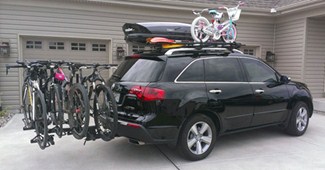
When choosing a bike rack that is compatible with your vehicle and bikes, it is important to consider four simple points:
- Vehicle compatibility
- Bike compatibility
- Vehicle accessibility
- User compatibility
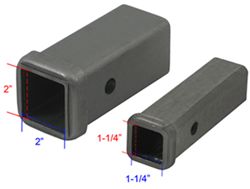
Vehicle Compatibility
What you need to know about your trailer hitch and vehicle to choose a bike rack that is compatible with your setup:
Q.What size receiver opening do you have?
- Most hitch receivers are either 1-1/4″ x 1-1/4″ or 2″ x 2″
- Bike racks are designed to fit 1-1/4″, 2″ or both sizes of receiver
- If you need to find the right trailer hitch for your vehicle, use our hitch fit guide
Q.Does your hitch receiver have a 1-1/4″ opening? If so, what class receiver is it?Guidelines, unless otherwise specified:
Class I
-
- 2,000 lbs towing capacity, 200 lbs tongue weight (information can be found on a sticker on the hitch or stamped into the hitch)
- Carries up to 2 bikes
Class II
-
- 3,500 lbs towing capacity, 350 lbs tongue weight
- Carries up to 4 bikes
Class III
-
- 3,500 lbs – 12,000 lbs towing capacity, 350 lbs – 1,200 lbs tongue weight
- Carries up to 5 bikes
A Class II only bike rack will not fit a Class I receiver hitch.
Q.Does your vehicle have a rear-mounted spare tire?
- A vehicle with a rear-mounted spare tire often requires a bike rack with a longer shank
- The shank is the square tube of metal that slides into the hitch receiver
- The right size shank will prevent damage to your vehicle and bikes
- To determine the minimum required length for your bike rack’s shank, measure the distance from the center of the hitch pin hole on your hitch receiver to the outermost edge of the spare tire
Q.Do you drive a vehicle with low clearance?
- Ensure that the bike rack will have adequate ground clearance to avoid damage to the bikes and the rack.
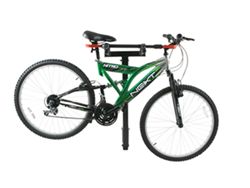
Bike Compatibility
Bike racks come in a variety of styles. Consider what style bike rack would be most compatible with your bike frames and transportation requirements.
Dual-Arm Bike Racks
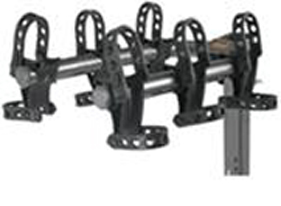
- Two cradles hold bike frame, providing even support
- Most compatible with standard-frame bikes (for example, mountain bikes and road bikes)
- Also compatible with alternative-frame bikes (for example, women’s and children’s bikes)
- For best fit with alternative frames, an adapter bar may be necessary
- Capacity: up to 5 bikes
- If bikes tilt while cradled (for example, with alternative-style frames), ensure that bikes have adequate ground clearance
- Consider using an adapter bar to level the bike while it is mounted on the bike rack
- Some bike racks include anti-sway straps or cradles
- Additional points of contact with bike frame to hold bike more securely
- Prevent rocking during travel
- Reduce bike-to-bike and bike-to-vehicle contact
Arm Spacing
Widely spaced arms
- Provide extra support for bikes
- Ideal for carrying larger bikes
- Smaller bikes (for example, children’s bikes) can be difficult to load
Narrowly spaced arms
- Compatible with a wide range of bike sizes
- Loading smaller bikes can be hassle free
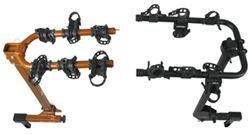
Single-Arm Bike Racks

- Bike frame is supported by single cradle
- Can easily accommodate both standard- and alternative-frame bikes
- Some alternative-frame bikes with large-diameter tubes may require a bike adapter bar
- Capacity: up to 5 bikes
- Easy loading
- Cradle styles
Single, rotatable cradles with individual top plates
- Cradles rotate to keep bike wheels level, providing excellent ground clearance
- Hand knob lets you secure bike frame to rack by tightening top plate
- Accommodate most styles and sizes of bikes
- Simple loading
- Bulky cradles can make it difficult to secure bikes with small crossbars (as found on children’s bikes)

Single, fixed cradle with single top plate
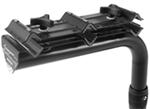
- Single top plate secures all cradles simultaneously
- Top plate must be removed to load and unload any bike
- Alternative-frame bikes often tilt when cradled from a slanted cross tube
- When tilted, bikes require adequate ground clearance
Wheel-Mount Bike Racks
- Wheel mounts cradle bike tires, securing bike to rack
- Adjustable wheel holder easily accommodates the widest range of bikes regardless of size, frame, suspension or wheel size
- Extremely easy loading and unloading
- Capacity: 2 bikes
- Add-ons for 2″ receivers can raise rack capacity to 4 bikes
- Eliminates swaying with unique holding method
- Bikes are secured with a wheel or frame clamp
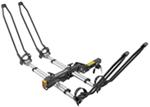
Wheel-Frame Clamps
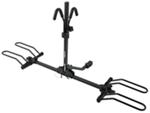
Wheel clamp
- Clamps down on bike wheels
- No frame contact
- Great for bikes with suspension
Frame clamp
- Large hook clamps to crossbar, holding the bike frame in place
- Simple to secure
- Straps secure wheels in cradles
V-Shaped Bike Racks
- Use a strap to secure bike wheels to the cradles
- Adjustable cradles accommodate all styles of bikes, regardless of frame or size
- Capacity: 2 to 4 bikes
- Less sway protection than some other style racks
- Simple loading
- No contact with the bike frame
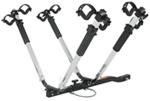
Vehicle Accessibility
Varying levels of rear cargo area accessibility are offered by different types of hitch-mounted bike racks.
Swing-Away Bike Racks
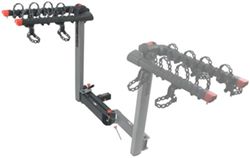
- Rack swings bikes completely away from vehicle
- Unlimited access to the rear of the vehicle
- Bikes can remain on the rack when the swing feature is in operation
- Easy to operate, usually by removal of a pin and clip
Parallelogram Bike Racks
- Entire rack extends away from the vehicle
- Limited access to the rear of the vehicle
- Rack remains behind vehicle, but rear hatch or door can be opened
- Bikes can remain on rack while it is extended
- Rack arms remain parallel to the ground, keeping bikes upright when rack is extended
- Operated with the pull of a switch
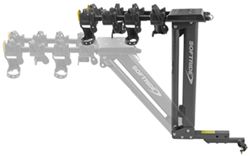
Tilting Bike Racks
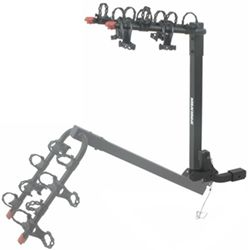
- Rack tilts down at the base of the rack
- Limited access to the rear of the vehicle
- Rack remains behind vehicle, but rear hatch or door can be opened
- Bikes must be removed before tilting
- Operated with pull of a switch or removal of pin and clip
- Fixed-Position Bike Racks
- Bikes and rack must be removed to gain access to the rear of the vehicle
User Compatibility
Choose a rack with features that make it convenient and easy for you to handle.
How easily can the rack be installed?
- Most racks are simple to install
- Heavier racks may be more difficult to install and carry
- Steel models are heavier than aluminum models

How often will you use accessibility or folding features?
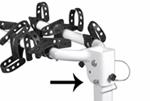
- Features are operated with a pin and clip or with a switch
- See individual product descriptions and/or video reviews for information on specific features
- Switch
- Easy to use
- A pull of the lever operates the bike rack’s feature
- No loose parts
- Pin and clip
- Pin secures mechanism in place
- Removal of pin allows for feature to be operated
What type of anti-rattle device does the rack use?
- Anti-rattle devices eliminate rattling and jostling of the rack in the hitch during transport.
- Twist-knob anti-rattle device
- Extremely convenient
- Simple knob twist gives the bike rack a snug fit within the hitch
- Does not require tools
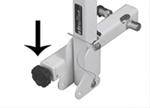

- anti-rattle hitch bolt
- Bolt threads through hitch and receiver
- Tightening the bolt creates stability
- Requires wrench (often included with bolt)
Does the bike rack offer an integrated locking system?
Several bike racks come with integrated locking mechanisms to prevent theft by securing the bikes to the bike rack and/or the bike rack to the trailer hitch.
- integrated cable lock
- Bike rack will have an integrated cable that secure bikes to the rack
- Lock stored on bike rack when not in use
- See individual rack descriptions for more details
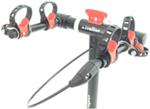

- Lockable cradles
- Available on single-arm bike racks
- Outer-cradle top plate locks bike into place, preventing removal of all bikes from the rack
- Hitch locks
- Included with some bike racks
- Secures bike rack to the vehicle
- See individual bike racks for details
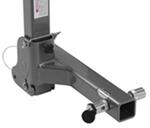
How much space is available to store the rack?

- Most styles of racks have a folding component that make storing the rack convenient
- Some racks fold up so they can be easily stored in a trunk or garage with limited space
- Some have removable arms, for compact storage
- See individual products for their folding and storage potential
Will you be towing as well as using a bike rack?
A variety of towing bike racks allow you to tow a trailer while carrying your bike rack
Vehicle Clearance
To determine the amount of clearance your vehicle requires, you need to measure. This requires a measuring tape and a straight edge, such as a dowel rod or a yardstick.
Step 1
Hold the dowel rod or yardstick vertically against the back of your spare tire, making sure that the end of the straight edge extends lower than your hitch pin hole.
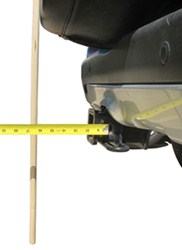
Step 2

Use the tape measure to find the distance from the center of the hitch pin hole to the straight edge (in inches). Be sure to form a 90-degree angle between your tape measure and your straight edge. This measurement is the minimum clearance your bike rack will need to clear your spare tire.
